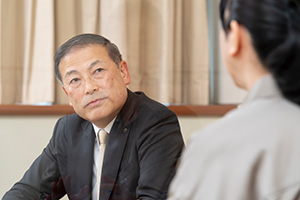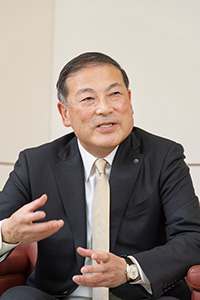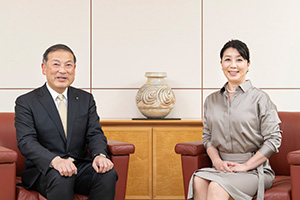 |
|
|
|
|
|
View from the Top Vol. 19, No. 6, pp. 1–5, June 2021. https://doi.org/10.53829/ntr202106tp1
Passing on Expertise and Enthusiasm in the New Era through IOWN Initiatives and Making Front-line Employees ShineOverviewIn today’s society, in which technological innovation and market changes are accelerating, NTT EAST is committed to solving problems of local communities while valuing the ties that it has cultivated with those communities over the more than 100 years in the telephone business. We interviewed Hiroshi Tanabe, senior executive vice president of NTT EAST, about his thought on the use of technology to solve social problems and why he has been focusing on helping front-line employees shine. Keywords: ICT, digital transformation, front line Meet the expectations of local communities by considering changes in ways to use information and communication—A little over a year has passed since you were appointed senior executive vice president. How do you feel about the unprecedented situation since then? First of all, I would like to thank all our employees and partners for their support and cooperation during this difficult period of the novel-coronavirus (COVID-19) pandemic. Looking back on this unprecedented situation from a technological perspective, tremendous achievements in medical technology have been made. It took only about a month after COVID-19 was identified to pinpoint the causative virus and its genome sequence. After that, PCR and other testing methods were established, and within a year of COVID-19 identification, vaccines were being manufactured. Another example of the extremely high level of technology was the impact of droplets exhaled on other people was simulated using a supercomputer. Although my knowledge of pandemics is based on novels, such as “The Plague” and “The Red Zone,” I am reminded of today’s advances in medical technology in light of the fact that during past pandemics, medical workers on the front line had no choice but to wait for the disease to end without knowing how to fight it. Regarding the present pandemic, I express my heartfelt gratitude to the medical personnel who are struggling to cope with increasing cases caused by the spread of variants of COVID-19. In this environment, as exemplified by the spread of teleworking, the ways to use information and communication technology (ICT) have changed dramatically over the past year. To support this dramatic change, we have invited a researcher, who also belongs to the University of Tsukuba, the Information-technology Promotion Agency, Japan, and other institution, to join our company, and developed and provided a virtual private network-based remote desktop service called “thin telework system” as a support tool for teleworking, which has been well received. Many local governments have chosen NTT EAST as a partner in the GIGA School Initiative of the Ministry of Education, Culture, Sports, Science and Technology, which aims to create an educational and ICT environment that nurtures children’s creativity in Society 5.0. I am grateful that we can be of service to society during this difficult period. —It must have been hard for the front-line employees to take countermeasures against COVID-19 infection. Until March 2020, since we did not know the impact of the COVID-19 pandemic on our customers, we carried out repairs and construction work to enable telework. As I mentioned above, as the reality of COVID-19 has gradually become clearer, we have been able to take countermeasures to ensure the safety of our customers, all persons concerned, and our employees. Furthermore, the outbreaks and clusters of infection in call centers have been reported worldwide. Our business is supported by many people at our call centers, which respond to telephone-service breakdowns and general inquiries about products and services, and we have been able to suppress cluster outbreaks and minimize infections among our call-center workers by taking countermeasures using our past knowledge. Taiwan has succeeded in containing the COVID-19 pandemic by using digital technology. I believe that we can contribute to prevent the spread of virus in Japan by further using our technology in cooperation with medical facilities. One example is the use of our Digital Twin Computing to connect the real world with cyberspace. I think that by using this technology to perform calculations, such as simulating infection routes and identifying the source of clusters, and feed the results back to the real world, it will be possible to prevent the next pandemic. Such technology has great potential, and I want us to contribute to society by implementing it.
We want to be firmly rooted in the community in new areas—Even in the face of the COVID-19 pandemic, NTT EAST continues to take on challenges, doesn’t it? About three years ago, to establish firm roots in the local community in new areas, we started an initiative in which branch managers and area business managers visit customers to listen to their problems and requests. The majority of the comments we received were issues related to the primary industries of agriculture, forestry, and fisheries. With those comments in mind, we are striving to contribute to solving the problems faced by local companies and governments by making full use of our strength in ICT. Specifically, to support agriculture, which is a major industry in many regions, we have started various businesses. NTT AgriTechnology was established in July 2019 to revitalize the local economy and advance urban development by using advanced technology to discover new possibilities and value in the agricultural industry. Biostock was established in July 2020 to build a sustainable regional recycling ecosystem in the livestock and dairy industries. NTT e-Drone Technology was established in February 2021 to develop industrial drones initially for agricultural use. —The term “digital transformation (DX)” has become familiar, and expectations for ICT to solve social issues are rising. In addition to the businesses described above, we have launched several companies that use our ICT to solve customers’ problems. It is expected that working styles that use cloud technology, including teleworking during the COVID-19 pandemic, will become the standard rather than being transient. Although the needs to improve business operations and promote DX by introducing public cloud services are becoming apparent, many customers are hesitant to introduce cloud services because they do not know much about them. To solve this problem, in July 2020, Nextmode was established to support our customers’ sustainable growth through our network and cloud-computing capabilities. What’s more, to create new connections and experiences as well as new cultures and societies while contributing to regional revitalization through e-sports (the domestic market for which will reach about 10 billion yen in 2022), NTTe-Sports was launched in January 2020. NTT ArtTechnology was also established in December 2020 to contribute to regional revitalization and economic circulation by disseminating valuable culture and art of regions through digitalization and connecting region to region and connecting regions to the world. I believe that we can leverage our strengths in various fields. In collaboration with universities, we have had quite a few collaborations with faculties of engineering, however, we are also promoting collaborations with researchers in other fields, and I want to further strengthen those collaborations from now onwards. Universities are rooted in the local community, and many professors are not only experts but are also active as hubs for solving local problems. There may be some fields that require ICT, so I want to combine our strengths with those of these experts to solve local problems.
Passing on expertise and enthusiasm—You have been with NTT for 34 years. What’s the journey been like? I am very attached to NTT Technical Journal (original Japanese version of NTT Technical Review). One year after I joined NTT, I was assigned to the Technology Development Department, where I was told to gather all the back issues of “Tsuuken Geppou” (“The Monthly Journal of the Electrical Communication Laboratory,” the predecessor of NTT Technical Journal) and “Shisetsu” (Facilities) and create a detailed chronology of various communication technologies and the ideas of the people in charge of those technologies. Therefore, I dug up those dusty issues from the library of the NTT Hibiya Building and tabulated them in chronological order. When I was asked to be interviewed for this issue, the first thing that sprung to mind was the file containing those back issues. I was then engaged in developing structures around cables and optical-related systems. At the time, I was doing basic research at NTT laboratories, writing specifications at the Technology Development Department to introduce those research results in business, and discussing specifications with manufacturers and persons in charge at the site of introduction every day to make them tangible. On one occasion, I was told by a senior colleague to read a vast amount of documents in the library before a meeting. Those documents described discussions about costs and technologies that had been held over the previous few years. By reading those documents before the meeting, I learned the background of the discussion, and I understood what was being discussed. I was reminded of my naivety every time I read those documents—which my seniors had left behind as proof of their exhaustive pursuit of their mission to provide high-quality services to customers. This custom can be described as having established a mechanism for passing on—from seniors to juniors—background and enthusiasm related to the development of technology. However, we live in an age that demands speed, and unlike the days that I described above, NTT-driven technology is no longer dominant, so we are not necessarily at the center of technology. It is important how quickly we can put technologies and services from around the world into an easy-to-use form for customers. The Innovative Optical and Wireless Network (IOWN) will allow NTT to take the lead in creating partnerships, and I believe that NTT’s expertise and enthusiasm for research and development in the new era will be handed down from generation to generation through this initiative. —What have you valued when passing on your expertise and enthusiasm? When I look back on my life journey as an engineer, I think my main concern over the past ten years has been how to polish the front-line employees’ skills so that they can shine at work. Thirteen years ago, I was transferred to Iwate Prefecture as a branch manager. At that time, the front-line work was not the first focus of attention, namely, new employees had not been assigned to positions, and existing employees were struggling to do their jobs. To overcome these difficult circumstances, even after returning to the headquarters, I was thinking of a system for supporting and training front-line employees. Although ten years have passed since the Great East Japan Earthquake, I still recall how our employees at the Iwate branch worked with the spirit of “We will protect the communications in this area ourselves” after the disaster struck. Since many problems in disaster sites often have to be dealt with manually, it is vital to have that kind of spirit. In fact, I want to draw attention to the fact that front-line employees deal with customers with pride and outstanding productivity not only in the event of disasters but also in normal times. Given those circumstances, I have been focusing on productivity, changing the work style and culture in the field, and upgrading work through DX. Through these activities, I have tried to get people to understand that change is required, even on the front lines, so that those on the front lines can shine. Currently, I am the head of the Digital Transformation Headquarters, and I believe that this kind of effort is necessary regardless of whether you are working in the field or at the headquarters. By embracing DX, we hope to further strengthen our ability to connect our diverse technologies and expertise with the needs of our customers throughout Japan and provide solutions to customers’ problems. —You’ve been through a lot of intense situations. Do you have any unforgettable experience? Even today, I feel the anguish caused by the Great East Japan Earthquake. On the day of the earthquake, I was at NTT EAST’s headquarters in Hatsudai in Tokyo while on a business trip, and immediately after the earthquake had struck, I had no way to return to the Iwate branch. In the early morning of the day that I was finally able to return to Iwate via Akita airport, I got a phone call from an employee at the disaster site. The employee said, “When people see us wearing NTT work clothes, they ask us to convey their messages to their families that they are safe,” and asked me if it is OK to meet such requests. When I replied, “First you must restore the facilities,” the caller said, “Do you know what is going on at the site? You are always telling us to work for the community!” and hung up the phone. I still remember how proud I was of the employees when I returned to the branch and saw not only the employee who had conveyed the message of the victims but also all the other employees working hard on site to restore the damaged facilities and support our customers. What’s more, the employees who were due to retire at the end of March 2011, shed tears when they said, “I cannot retire at this time. I want to be allowed to work until this crisis is over.” Even now, my heart aches at the fact that the only thing I could do was to say “Thank you for your tremendous efforts” to the employees who worked so desperately to contribute to the community and complete their mission to connect communications as social infrastructure. This experience has led me to focus on highlighting the front lines and helping front-line employees shine; however, if I feel strongly that things are fine the way they are, we won’t be able to meet the expectations of our customers. Just as the means of communications has changed from fixed-line telephones to cell phones, the expectations of customers have also changed over time. I also think it is important to expand the spirit of pride in one’s work that has supported these front lines in new directions. I want to make the front lines shine by multiplying new fields and communications. —What is your message to those who are engaged in research and development? I think that NTT’s research labs can now be given clear direction on the basis of IOWN, and I feel the enthusiasm and momentum of researchers toward that goal. I hope our researchers will lead the NTT Group—and society as a whole—with confidence and pride in the fact that nothing is wasted in research and development.
Interviewee profileCareer highlightsHiroshi Tanabe joined Nippon Telegraph and Telephone Corporation in 1987. In his career at NTT EAST, he became manager of the Iwate branch office in 2008; senior manager of the Plant Department, Network Business Headquarters, in 2011; executive manager of the Engineering Department, Network Business Headquarters, in 2013; board of director in 2015; executive vice president in 2018; senior executive vice president, senior executive manager of the Digital Transformation Headquarters, president of NTT E-Asia, and president of NTT e-Drone Technology in 2000. |




